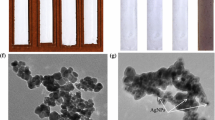Abstract
The mechanism of the inactivation of Lactobacillus casei phage PL-1 suspended in a phosphate buffer by black-light (BL) -catalytic titanium dioxide (TiO2) thin film was studied. Generation of both superoxide anions (O2 −) and hydroxyl radicals ( · OH) was confirmed in the aqueous medium in which TiO2 film was settled with BL irradiation under gentle shaking. With BL-irradiation alone without TiO2 film, only O2 − was generated to some extent. The genome DNA inside the phage particles was found to be fragmented by the treatment of PL-1 phages with BL-catalytic TiO2 film. The phage inactivation by BL-catalytic TiO2 film was inhibited by the addition of albumin in a concentration-dependent manner. BL-catalytic TiO2 film was considered to cause primarily the damage to the capsid protein through the generation of active oxygen species such as · OH, followed by damage to the genome DNA inside the phage particles.
Similar content being viewed by others
Author information
Authors and Affiliations
Additional information
Received: 11 August 2000 / Accepted: 30 August 2000
Rights and permissions
About this article
Cite this article
Kashige, N., Kakita, Y., Nakashima, Y. et al. Mechanism of the Photocatalytic Inactivation of Lactobacillus casei Phage PL-1 by Titania Thin Film. Curr Microbiol 42, 184–189 (2001). https://doi.org/10.1007/s002840010201
Issue Date:
DOI: https://doi.org/10.1007/s002840010201




